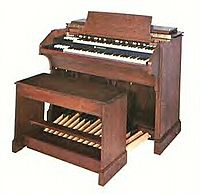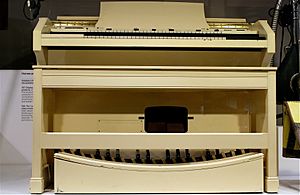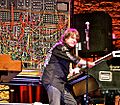Hammond organ facts for kids

A Hammond C-3 organ.
|
|
| Invented by: | Laurens Hammond |
|---|---|
| Introduction Date: | 1935 |
| Hammond organ | |
The Hammond organ is a special keyboard instrument that looks a bit like a piano. Most Hammond organs make sound using spinning metal wheels and electricity. It's an electric version of a pipe organ. Laurens Hammond and John M. Hanert invented it. The first one was built in 1935.
You can change the sound of the organ using sliding "drawbars." The Hammond organ became very popular. Almost two million of them were sold!
Contents
How the Hammond Organ Works
Keyboards and Pedals
Most Hammond organs have two keyboards. Organ players call these "manuals." They are smaller than piano keyboards and are stacked one on top of the other. This lets the organist play both at the same time. The keys on a Hammond organ are lighter and easier to press than piano keys. This helps organists play notes very quickly.
The pedalboard on a Hammond organ looks like a very big piano keyboard. You play it with your feet! It makes very low sounds, which are called bass notes. You can play both manuals and the pedalboard at the same time. This helps you create many different and complex sounds.
Sound Controls: Drawbars
The sounds from the manuals and pedalboard are changed by switches called drawbars. You pull them out to make the sound louder. Pushing them in makes the sound softer. Each manual has nine drawbars. They control different parts of the sound. Drawbars on the left make lower sounds. Those on the right make higher sounds. The pedalboard has two drawbars, and they both control low sounds.
Special Effects: Percussion
Hammond organs have a cool feature called "percussion." This lets you add short, melodic clicks to your music. It's controlled by switches on the upper left side of the organ. Percussion adds extra tones, called harmonics, to the melodies you play.
Sound Effects: Vibrato and Chorus
You can change the organ's sound even more with a special knob. This knob adds "vibrato" or "chorus" to the music. Vibrato is a tiny change in how high or low a note sounds. It makes the notes sound a bit "wobbly." Chorus adds extra notes to the ones you are playing. This makes the sound seem more "full" and rich.
History of the Hammond Organ
Early Ideas
The Hammond organ was inspired by an older instrument called the Telharmonium. The Telharmonium made sounds in a similar way, using spinning metal discs. Laurens Hammond, the inventor, used to make clocks. He created a special clock motor that could be used for other things. He used this motor to build the first Hammond Organ.
Tonewheel Organs

Most Hammond organs you hear are "tonewheel organs." This means they make sound using spinning metal discs. These discs have small bumps on their edges. An electric signal passes over these bumps. The signal then gets louder using an amplifier. Hammond's A, B, C, D, and RT series organs use tonewheels. Many experts say these models are the best. Hammond made tonewheel organs from 1935 to 1975.
Transistor Organs
After making tonewheel organs, Hammond started making "transistor organs." These organs did not use tonewheels. Instead, they used computer circuits to create sounds. Most Hammond organ players did not like the sound of the transistor organs as much. So, they quickly became less popular. Hammond made transistor organs from 1975 to 1985. After that, the Hammond Organ Company stopped making them.
The Hammond Organ's Sound
Tone Generator
The "tone generator" inside a Hammond organ has many tonewheels. These wheels all spin at the same speed. Electric signals and amplifiers make the sounds louder.
Speakers
The most common speaker used with a Hammond organ is called a Leslie speaker. Don Leslie made it. It makes the organ sound like a pipe organ. It does this by rotating the speakers inside its cabinet. Hammond did not make Leslie speakers. But many people loved them so much that they bought them anyway. Another option was the Hammond Tone Cabinet, but it was not as popular.
Famous Players
- Jimmy Smith
- Paul DeFrancesco
Related pages
Images for kids
-
The Hammond SK1 could also sound like electric pianos and other keyboards, not just organs.
-
A test light-weight tonewheel generator. It was made at the Hammond Organ Company's factory in Antwerp.
-
Jimmy Smith started using the Hammond organ in the 1950s. His music became very popular and inspired other organists.
-
"I took to riding the L100 like a bucking bronco. It weighs 350 lb; when it's on top of you, you need the adrenalin rush you get onstage to chuck it around." Keith Emerson
-
Jon Lord played his Hammond C-3 through an overdriven Marshall stack. This helped it fit with Deep Purple's hard rock sound.
See also
 In Spanish: Órgano Hammond para niños
In Spanish: Órgano Hammond para niños


















